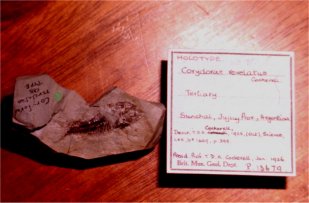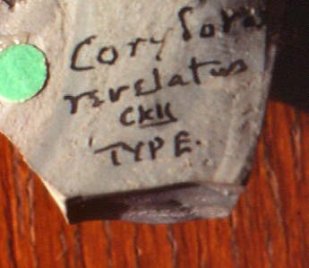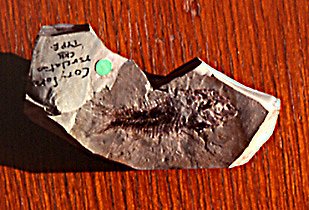SCOTCAT.COM
your internet guide to all things catfish
| Corydoras revelatus a Fossil Discovery |
by Allan James |
The last of the dinosaurs disappeared from the earth around 65 million years ago so our fossil friend Corydoras revelatus lived in the Tertiary period just after this, alongside the hairy mammal. It was discovered in Argentina in Sunchal, Juyuy province, by a well known entomologist, Professor T.D.A.Cockerell of the University of Colorado, Boulder, in 1925. He was actually searching along with his wife for fossil insects at the time before he came across our plated friend. The green Tertiary rock measured 32mm and the imprint 27mm and it bears the outline of a Corydoras (Sands,D. 1983) What was noticed was that a flaw in the rock suggested that the dorsal spine was longer (Isbrücker) and the problem of the one dimensional shape of the fossil made it the subject of a new species, Corydoras revelatus Cockerell, 1925. It is now housed in the British Natural History Museum, London.
The entomologist T.D.A."Theo" Cockerell (1866-1948) was better known for his work on the wild bees of Colorado and wrote many papers on these insects. He has even a mosquito from Florida named after him. Theo was the brother of the noted scholar Sir Sydney Cockerell who was high up the ladder of British society at the time.

How is a fossil formed?. Well this Corydoras died and was covered by the mud at the bottom of the river. The river would have dried up and the sediment compressed and hardened. The next process would be minerals which would seep through the bones which gradually change into rock. Millions of years later the fossil appears as the covering rock is worn away by wind and water.
Acknowledgment: Jim Makin for supplying images for this article. References: Sands, David; Catfishes of the World, Volume 1 Callichthyidae. Photo Credits: Top 2: Eric McCabe Bottom: Steve Pritchard |
If you would like to contribute an article, please e-mail me. You will of course be credited for your work.
If you would like to donate any denomination of money to the site just click the above link button. All proceeds will go to running the site and hopefully to keep it going for a few years yet.
Print or e-mail this factsheet below



